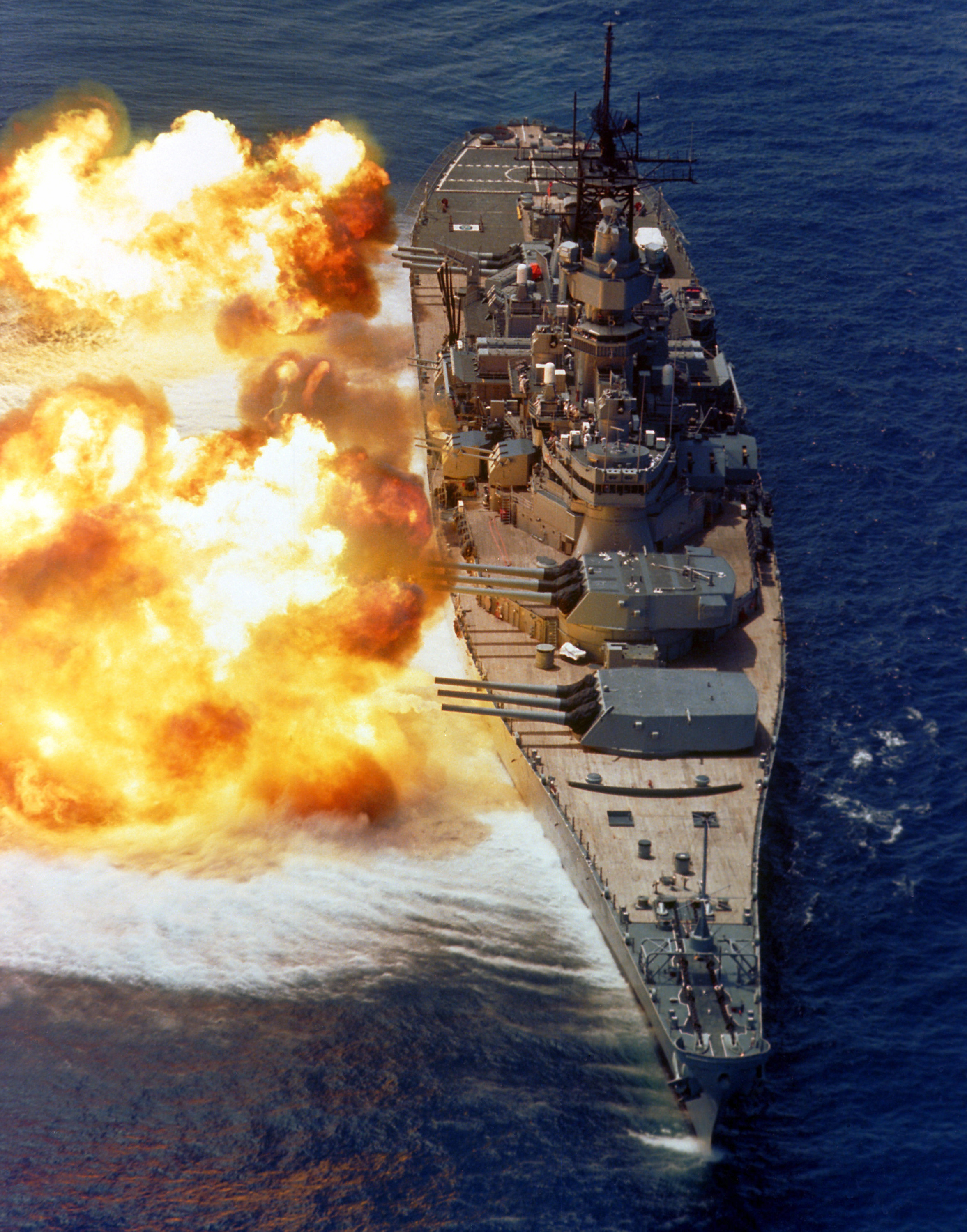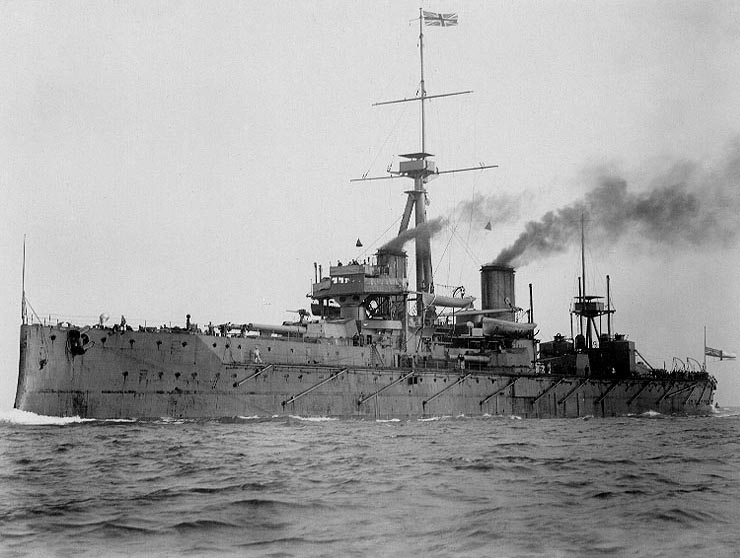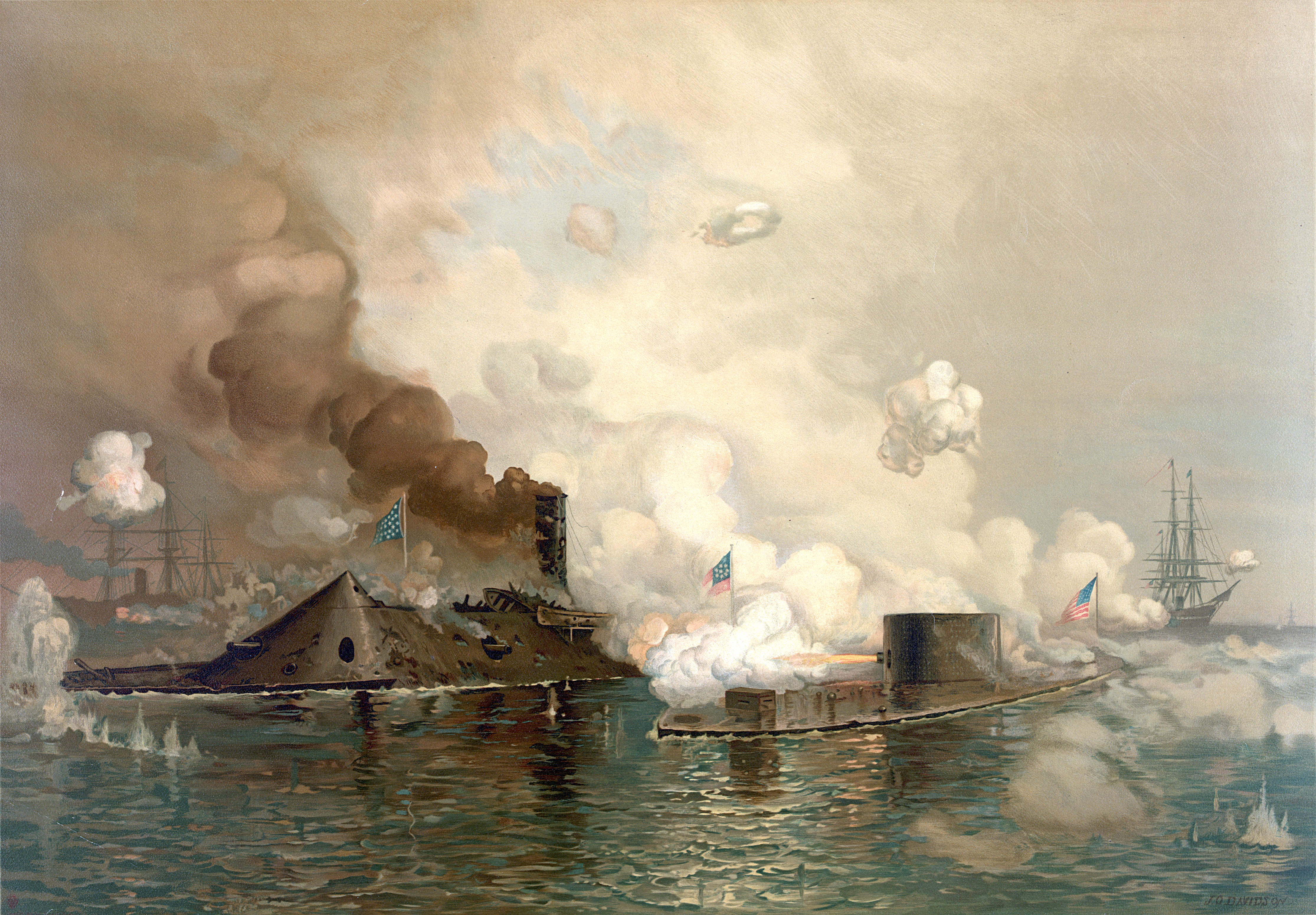|
Pre-dreadnought
Pre-dreadnought battleships were sea-going battleships built between the mid- to late- 1880s and 1905, before the launch of in 1906. The pre-dreadnought ships replaced the ironclad battleships of the 1870s and 1880s. Built from steel, protected by case-hardened steel armour, and powered by coal-fired triple-expansion steam engines, pre-dreadnought battleships carried a main battery of very heavy guns in fully enclosed rotating turrets supported by one or more secondary batteries of lighter weapons. In contrast to the multifarious development of ironclad warships in preceding decades, the 1890s saw navies worldwide start to build battleships to a common design as dozens of ships essentially followed the design of the Royal Navy's . The similarity in appearance of battleships in the 1890s was underlined by the increasing number of ships being built. New naval powers such as Germany, Japan, the United States, and to a lesser extent Italy and Austria-Hungary, began to estab ... [...More Info...] [...Related Items...] OR: [Wikipedia] [Google] [Baidu] |
Battleship
A battleship is a large armored warship with a main battery consisting of large caliber guns. It dominated naval warfare in the late 19th and early 20th centuries. The term ''battleship'' came into use in the late 1880s to describe a type of ironclad warship,Stoll, J. ''Steaming in the Dark?'', Journal of Conflict Resolution Vol. 36 No. 2, June 1992. now referred to by historians as pre-dreadnought battleships. In 1906, the commissioning of into the United Kingdom's Royal Navy heralded a revolution in the field of battleship design. Subsequent battleship designs, influenced by HMS ''Dreadnought'', were referred to as "dreadnoughts", though the term eventually became obsolete as dreadnoughts became the only type of battleship in common use. Battleships were a symbol of naval dominance and national might, and for decades the battleship was a major factor in both diplomacy and military strategy.Sondhaus, L. ''Naval Warfare 1815–1914'', . A global arms race in battleship con ... [...More Info...] [...Related Items...] OR: [Wikipedia] [Google] [Baidu] |
Dreadnought
The dreadnought (alternatively spelled dreadnaught) was the predominant type of battleship in the early 20th century. The first of the kind, the Royal Navy's , had such an impact when launched in 1906 that similar battleships built after her were referred to as "dreadnoughts", and earlier battleships became known as pre-dreadnoughts. Her design had two revolutionary features: an "all-big-gun" armament scheme, with an unprecedented number of heavy-calibre guns, and steam turbine propulsion. As dreadnoughts became a crucial symbol of national power, the arrival of these new warships renewed the naval arms race between the United Kingdom and Germany. Dreadnought races sprang up around the world, including in South America, lasting up to the beginning of World War I. Successive designs increased rapidly in size and made use of improvements in armament, armour and propulsion throughout the dreadnought era. Within five years, new battleships outclassed ''Dreadnought'' herself. ... [...More Info...] [...Related Items...] OR: [Wikipedia] [Google] [Baidu] |
Imperial Japanese Navy
The Imperial Japanese Navy (IJN; Kyūjitai: Shinjitai: ' 'Navy of the Greater Japanese Empire', or ''Nippon Kaigun'', 'Japanese Navy') was the navy of the Empire of Japan from 1868 to 1945, when it was dissolved following Japan's surrender in World War II. The Japan Maritime Self-Defense Force (JMSDF) was formed between 1952–1954 after the dissolution of the IJN. The Imperial Japanese Navy was the third largest navy in the world by 1920, behind the Royal Navy and the United States Navy (USN). It was supported by the Imperial Japanese Navy Air Service for aircraft and airstrike operation from the fleet. It was the primary opponent of the Western Allies in the Pacific War. The origins of the Imperial Japanese Navy go back to early interactions with nations on the Asian continent, beginning in the early medieval period and reaching a peak of activity during the 16th and 17th centuries at a time of cultural exchange with European powers during the Age of Discovery. After ... [...More Info...] [...Related Items...] OR: [Wikipedia] [Google] [Baidu] |
Gun Turret
A gun turret (or simply turret) is a mounting platform from which weapons can be fired that affords protection, visibility and ability to turn and aim. A modern gun turret is generally a rotatable weapon mount that houses the crew or mechanism of a projectile-firing weapon and at the same time lets the weapon be aimed and fired in some degree of azimuth and elevation (cone of fire). Description Rotating gun turrets protect the weapon and its crew as they rotate. When this meaning of the word "turret" started being used at the beginning of the 1860s, turrets were normally cylindrical. Barbettes were an alternative to turrets; with a barbette the protection was fixed, and the weapon and crew were on a rotating platform inside the barbette. In the 1890s, armoured hoods (also known as "gun houses") were added to barbettes; these rotated with the platform (hence the term "hooded barbette"). By the early 20th Century, these hoods were known as turrets. Modern warships have gu ... [...More Info...] [...Related Items...] OR: [Wikipedia] [Google] [Baidu] |
Ironclad Warship
An ironclad is a steam engine, steam-propelled warship protected by Wrought iron, iron or steel iron armor, armor plates, constructed from 1859 to the early 1890s. The ironclad was developed as a result of the vulnerability of wooden warships to explosive or incendiary shell (projectile), shells. The first ironclad battleship, , was launched by the French Navy in November 1859 - narrowly pre-empting the British Royal Navy. They were first used in warfare in 1862 during the American Civil War, when ironclads operated against wooden ships and, in a historic confrontation, against each other at the Battle of Hampton Roads in Virginia. Their performance demonstrated that the ironclad had replaced the unarmored ship of the line as the most powerful warship afloat. City-class ironclad, Ironclad gunboats became very successful in the American Civil War. Ironclads were designed for several uses, including as high seas battleships, long-range cruisers, and Littoral (military), coast ... [...More Info...] [...Related Items...] OR: [Wikipedia] [Google] [Baidu] |
HMS Ocean (Canopus-class Battleship)
Six ships that were built for the Royal Navy have borne the name HMS ''Ocean''. The name ''Ocean'' entered the list from which names are selected for British ships in 1759, when the Royal Navy captured the French ship named . The British studied the French technology of this ship and admired it, but the ship had to be in bad shape before it would be replaced by a new-build. * , was a 90-gun ship of the line built in 1761. * , was a 98-gun ship of the line launched in 1805, active in the Napoleonic Wars, and later upgraded to a 110-gun first-rate. * was originally ordered to be built as a ''Bulwark''-class wooden screw line-of battle ship intended to carry 91 guns. However, the order was changed and she was eventually launched in 1863 as a of 24 guns. In the late 1860s she served as flagship to the Commander-in-Chief, China and after an active life of only six years, was paid off in 1872. * was a ''Canopus''-class pre-dreadnought battleship launched in 1898 and sunk by a mine ... [...More Info...] [...Related Items...] OR: [Wikipedia] [Google] [Baidu] |
Empire Of Japan
The also known as the Japanese Empire or Imperial Japan, was a historical nation-state and great power that existed from the Meiji Restoration in 1868 until the enactment of the post-World War II 1947 constitution and subsequent formation of modern Japan. It encompassed the Japanese archipelago and several colonies, protectorates, mandates, and other territories. Under the slogans of and following the Boshin War and restoration of power to the Emperor from the Shogun, Japan underwent a period of industrialization and militarization, the Meiji Restoration, which is often regarded as the fastest modernisation of any country to date. All of these aspects contributed to Japan's emergence as a great power and the establishment of a colonial empire following the First Sino-Japanese War, the Boxer Rebellion, the Russo-Japanese War, and World War I. Economic and political turmoil in the 1920s, including the Great Depression, led to the rise of militarism, nat ... [...More Info...] [...Related Items...] OR: [Wikipedia] [Google] [Baidu] |
Battleship Secondary Armament
Secondary armament is a term used to refer to smaller, faster-firing weapons that were typically effective at a shorter range than the main battery, main (heavy) weapons on military systems, including battleship- and cruiser-type warships, tanks/armored personnel carriers, and rarely other systems. The nature, disposition, size and purpose of Naval secondary weapon systems changed dramatically as the threat changed from torpedo boats, to torpedo-carrying destroyers, to aircraft, to anti-ship missiles. Naval Pre-dreadnought era Pre-dreadnoughts, from the period 1890 to 1905, were typically fitted with 3 or 4 different calibres of weapon. The main guns were usually approximately 12-inch caliber, secondary weapons usually 6-inch but typically in the range 5-inch to 7.5-inch. Guns smaller than 4.7-inch are usually considered "tertiary". (Many pre-dreadnoughts also carried 9.2 to 10-inch "secondary" guns, but they are usually treated instead as a mixed-caliber main armament. ... [...More Info...] [...Related Items...] OR: [Wikipedia] [Google] [Baidu] |
Battle Of Tsushima
The Battle of Tsushima (Japanese:対馬沖海戦, Tsushimaoki''-Kaisen'', russian: Цусимское сражение, ''Tsusimskoye srazheniye''), also known as the Battle of Tsushima Strait and the Naval Battle of Sea of Japan (Japanese: 日本海海戦, Nihonkai''-Kaisen'') in Japan, was a List of battles of the Russo-Japanese War, major naval battle fought between Russia and Japan during the Russo-Japanese War. It was naval history's first, and so far the last, decisive sea battle fought by modern steel battleship fleets and the first naval battle in which wireless telegraphy (radio) played a critically important role. It has been characterized as the "dying echo of the old era – for the last time in the history of naval warfare, Ship of the line, ships of the line of a beaten fleet surrendered on the high seas". It was fought on 27–28 May 1905 (14–15 May in the Julian calendar then in use in Russia) in the Tsushima Strait located between Korea and southern Japan ... [...More Info...] [...Related Items...] OR: [Wikipedia] [Google] [Baidu] |
BL 12 Inch Mk X Naval Gun
The BL 12 inch Gun Mark XMark X = Mark 10. Succeeding versions were Mark XI (11) and XII (12). Britain used Roman numerals to denote Marks (models) of ordnance until after World War II was a British 45-calibre naval gun which was mounted as primary armament on battleships and battlecruisers from 1906. It first appeared on . History Mk X continued the trend of lengthening gun barrels as far as new construction methods would permit, in order to allow more cordite propellant to be used to attain higher projectile velocities. Mk X increased the bore length from Mk IX's , increasing muzzle velocity from . Subsequent British attempts to further increase the power of 12-inch guns led to failure with the 50-calibre Mk XI and Mk XII guns; the Mk X was the last successful 12-inch British gun. Naval use Mk X guns were mounted in the following ships which served throughout World War I: * s, laid down 1905, completed 1908 * Battleship , laid down 1905, completed 1906 * s, la ... [...More Info...] [...Related Items...] OR: [Wikipedia] [Google] [Baidu] |
Steam Turbine
A steam turbine is a machine that extracts thermal energy from pressurized steam and uses it to do mechanical work on a rotating output shaft. Its modern manifestation was invented by Charles Parsons in 1884. Fabrication of a modern steam turbine involves advanced metalwork to form high-grade steel alloys into precision parts using technologies that first became available in the 20th century; continued advances in durability and efficiency of steam turbines remains central to the energy economics of the 21st century. The steam turbine is a form of heat engine that derives much of its improvement in thermodynamic efficiency from the use of multiple stages in the expansion of the steam, which results in a closer approach to the ideal reversible expansion process. Because the turbine generates rotary motion, it can be coupled to a generator to harness its motion into electricity. Such turbogenerators are the core of thermal power stations which can be fueled by fossil- ... [...More Info...] [...Related Items...] OR: [Wikipedia] [Google] [Baidu] |






.jpg)
_12-inch_gun_replacement_at_Malta_1915.jpg)
